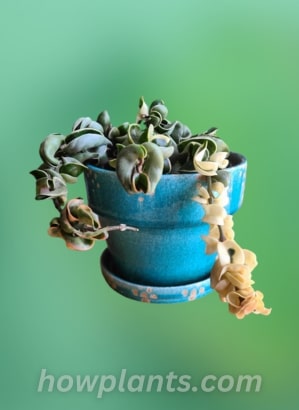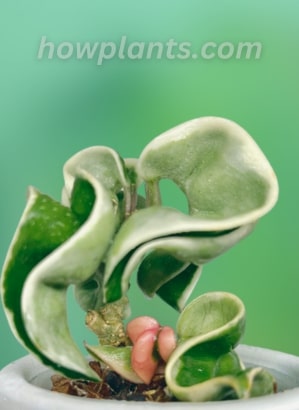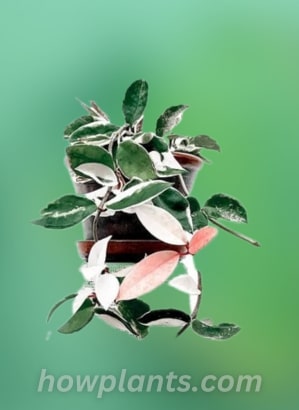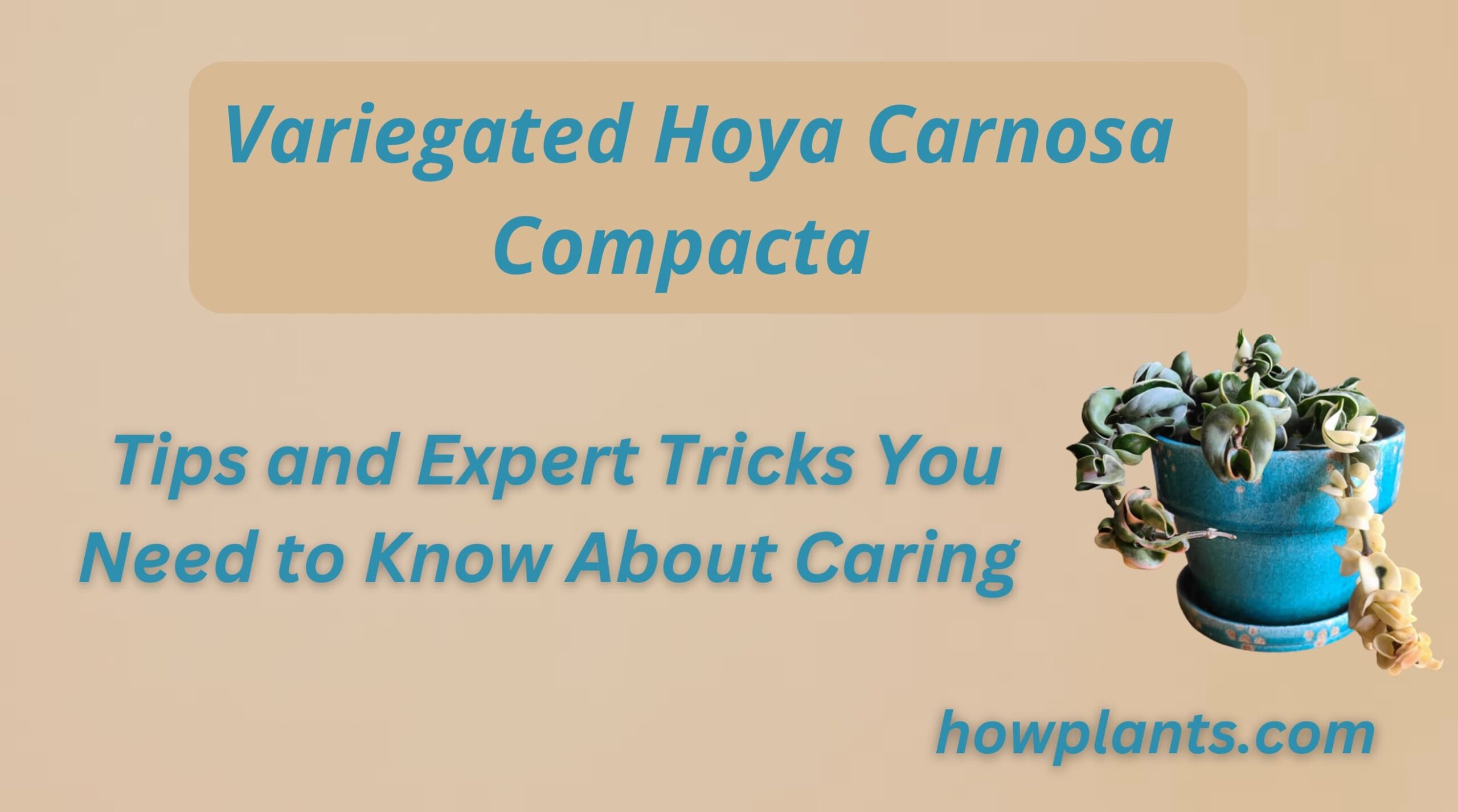Are you looking for information on how to care for Hoya Compacta Variegata? Look no further! In this blog post, we will dive into all the important details you need to know about caring for this stunning houseplant. We will discuss the best potting soil and how to water, how to repot, and how to prune. Plus, we will also cover some of the common problems that you may encounter while caring for this plant. So, if you are ready to learn more about the Variegated Hoya Carnosa Compacta, let’s get started.
What is Hoya Carnosa Compacta Variegata?
Hoya carnosa compacta variegata is a variegated form of the common Hoya carnosa. It is a hardy, evergreen tree that can grow up to 12-20 feet tall. The succulent leaves are ovate to elliptical, in shape and are covered in short, spiny hairs with a serrated margin. The tree bears small, white flowers in early summer and are borne in clusters at the top of the stem. The fruit is a small, green capsule.
The Hoyas are small to medium-sized shrubs or small trees, typically growing from 2 to 6 meters tall. They have small, rounded leaves, and are covered in small, pale flowers. The flowers are typically white, but there are a variety of colors and patterns available, including variegated forms.

Origin and Family of Hoya Compacta Plant
The variegated hoya carnosa compacta is a shrub that originates from the Caribbean region. It is a member of the hoya family and is known for its variegated leaves. The hoya carnosa compacta variegata is a hardy plant that can grow up to 2 meters tall.
The Hoyas are a genus of flowering plants in the family Lamiaceae. They are native to temperate regions of the world, and are commonly found in moist areas, such as along streams and in damp soils. The genus is composed of about twenty species of shrubs or small trees, of which only a few are commonly grown as garden plants.
Hoya Carnosa Variegata Flower and Leaves morphology
The hoya carnosa compacta flowers are white, with a purple tinge, and are borne in panicles up to 20 cm long. Hoya compacta blooms are typically smaller than other varieties of Hoya carnosa compacta, but they also have a more variegated appearance. Carnosa compacta typically grow in late winter or early spring. The fruit is a globular capsule up to 8 cm wide. It is a shrub or small tree up to 3 m tall, with a trunk up to 25 cm diameter. The leaves are oppositely arranged, ovate to elliptical, 10-25 cm long and 5-10 cm wide, with serrated margins.
Size of Philodendron Hoya Carnosa
The size of variegated compacta varies depending on the growing conditions, but is typically between 12-20 feet tall and 3 feet when grown as an indoor plant.
Hoya Compacta Variegata Care
Hoya compacta care needs are as follows:
- Plant should be kept in a well-lit area with plenty of humidity
- Plant should be watered regularly
- Plant should be fertilized every two weeks
- Plant should be pruned regularly to maintain its shape and size

The best environmental conditions for hoya carnosa compacta variegata are partial to full sun, moist soil, and a pH of 6.0 to 7.5.
Growth Rate of Carnosa Compacta
The growth rate of Hoya carnosa compacta variegata is relatively slow, averaging around 1 cm per month. However, this species can also grow rapidly, reaching a height of up to 10 cm within a year. The flowers are small, white, and fragrant, and are borne in clusters at the tips of the branches.
Pots that are best
There are many different types and sizes of pots that are best for growing hoya carnosa compacta variegata. Some people prefer to grow their plants in clay pots, while others prefer to use plastic pots. It is important to choose a pot that is the right size for the plant and the soil that it will be planted in. Some people also prefer to use a soil mix that is specifically designed for hoya carnosa compacta variegata.
When to do repotting
If you notice any yellowing, wilting, or dieback of your hoya carnosa compacta variegata, it is important to report the issue to your local gardening center or nursery as soon as possible. This is an indication that your hoya carnosa compacta variegata may be in danger of succumbing to a serious disease, and may need to be replaced.
Soil best for Hoya Compacta
Hoya compacta variegata prefers a well-drained soil with a neutral to slightly alkaline pH.They are easy to grow, and are tolerant of a wide range of soils, from dry to wet. This species is tolerant of a wide range of soil moisture levels, but does best in moist to wet conditions. It is not recommended for growing in dry conditions.
Temperature best for Hoya
This tree prefers full sun to part shade. It is not tolerant of cold temperatures, and can be killed by frost.The Hoyas are hardy plants, able to tolerate a wide range of conditions, from full sun to partial shade. The ideal temperature for the growth of hoya carnosa compacta variegata is around 75-85 degrees Fahrenheit. This species is cold tolerant, growing well in zones 9-11
Ideal pH for Hoya Carnosa Compacta Variegata?
The ideal pH for hoya carnosa compacta variegata is 6.5 to 7.5. pH meter can be used to check the soil pH so that it can be adjusted according to the plant need.
Water Requirement
The water requirements of the hoya carnosa compacta variegata are as follows:
- A hoya carnosa compacta variegata requires 1 gallon of water per week.
- During the summer, when the plant is growing rapidly, you may need to water it more often.
- During the winter, when the plant is slowing down, you may need to water it less often.
Light Requirement
The light requirements for hoya carnosa compacta variegata are the same as for other types of hoya, which is indirect but bright sunlight for 6-8 hours. This species prefers filtered light and should be placed in a location that receives morning or afternoon sun. east or west facing windows are the best placements for these plants.
Fertilizers
Fertilizers that are suitable for enhancing the growth of hoya variegata include: a balanced fertilizer that contains nitrogen, phosphorus, and potassium, and a composted manure fertilizer. When to give fertilizer to hoya carnosa compacta variegata varies depending on the soil type, the weather, and the plant’s needs, but the best interval of time is between every 2-3months in spring and summer seasons.
Humidity and Aeration
Hoya rope variegata is a type of hoya that is known for its variegated leaves. The ideal humidity and aeration levels for this hoya are not well known, but it is likely that the levels should be around 40-60% humidity and 4-6 aeration.
How to Propagate Hoya Carnosa Compacta
Hoya carnosa compacta regalis variegata can be propagated by dividing the root ball, then rooting the divisions in water.
Steps of Propagation through stem cutting in soil
- Remove the old stem with a sharp knife.
- Cut the stem about 1 inch below the soil surface.
- Water the newly cut stem well.
- Place the newly cut stem in a propagator and mist it with water every day.
- When the stem has rooted, remove the propagator and water the stem regularly.
- When the stem is about 6 inches tall, cut it off at the ground level.
Steps of Propagation through stem cutting in water
Hoya rope can be propagated by stem cutting in water. The stem cutting method is a simple and easy way to propagate this plant.
- First, cut the stem of the hoya carnosa compacta variegata plant at a height of 1-2 inches below the soil surface. Make sure to cut the stem just below a node.
- Then, place the stem cuttings in water and wait for them to root.
- Once the stem cuttings have rooted, transfer them to a pot and water them regularly.
Toxicity status of Rope Hoya Carnosa
The toxicity status of the hoya carnosa compacta variegata plant is proved to be nontoxic. No toxic material is present in this plant so, if it is eaten by pet animals and human beings it will not cause any problem.
Pest that can attack Hoya Carnosa Variegata
Aphids
Aphids are small, soft-bodied insects that feed on plant sap. They can cause leaves to curl and turn yellow or brown, and can reduce the size and vigor of plants. Aphids are attracted to hoya carnosa compacta variegata by the sweet fragrance of the flowers. Use neam oil or alcohol against aphids. Replace the soil with new sterilized oil.
Mealy bugs
Mealy bugs are small, brown, wingless insects that feed on the leaves of the varigated hoya. They cause the leaves to become rough and bumpy, making them difficult to touch and causing the plant to lose its attractiveness to pollinators. There are several ways to get rid of mealybugs: using a bug spray, using a hoya carnosa compacta variegata insecticidal soap, using a hoya carnosa compacta variegata insecticidal oil, or using a hoya carnosa compacta variegata insecticidal powder.
Root rot
Root rot is a serious problem for variegated hoya rope. The fungus that causes root rot attacks the roots and can cause the tree to die. There is no cure for root rot, but there are steps that can be taken to minimize its effects.
If you notice root rot on your variegated hindu rope, you should take action right away. Remove the infected plants from the garden and make sure that they don’t spread the fungus to other plants. You can also try to treat the root rot with a fungicide. Be sure to follow the instructions carefully and keep track of the progress of the treatment.
If you notice root rot on your variegated rope hoya, contact a professional hoya carnosa compacta variegata grower to get help.
Other problems realated to Rope Hoya
Drooping Leaf
Leaves of the hoya variegated start to droop because of a lack of water and nutrients. The best way to avoid leaves drooping in Philodendron Atabapoense is to water the plant regularly and fertilize it monthly with a balanced fertilizer.
Leaves of hoya carnosa compacta variegata start to droop because of a deficiency in nitrogen. This deficiency can be avoided by fertilizing the plant with nitrogen-rich fertilizer.
Yellowing of Leaves
The leaves of the compacta become yellow because of a deficiency in the chlorophyll molecule. The yellowing of leaves can be avoided by fertilizing the plant with a high-quality fertilizer that contains chlorophyll.
Brown Tips
Variegated hoya carnosa is a type of hoya that can become brown over time. Browning is caused by the accumulation of natural sugars in the plant’s cells. Browning can be prevented by keeping the plant well-watered and fertilized.
Related Plants
Hoya Krimson Queen
Hoya krimson queen is a type of hoya that is known for its deep red color. It is a hardy plant that can grow in a variety of climates.

Hoya Australis
The Hoodia Gordonii is a succulent plant native to the arid regions of South Africa. Hoodia Gordonii is a cactus-like plant that grows to be about two feet tall. The Hoodia Gordonii is a natural appetite suppressant and has been used in traditional African medicine to help control obesity and weight gain. Hoodia Gordonii is also known to help improve energy levels, curb cravings, and improve mood.

Conclusion
In conclusion, hoya hindu rope variegated is a hardy, evergreen tree that has ovate to elliptical-shaped leaves and small, white flowers in early summer. It is an attractive and easy to care for plant that can reach up to 20 feet tall and bears small, green capsules as its fruit. With its unique features and low-maintenance requirements, this variegated form of the common Hoya carnosa makes an excellent addition to any garden.
